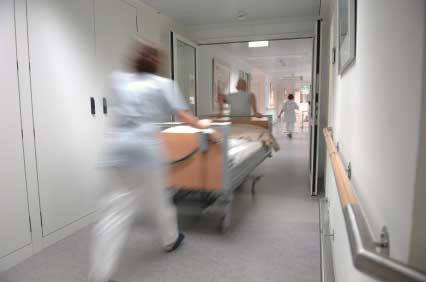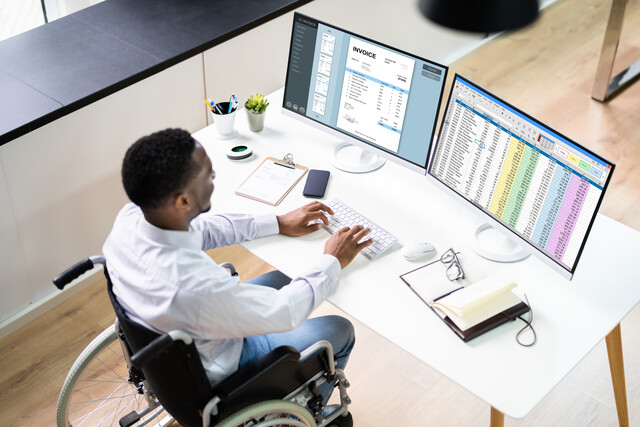As a Nursing Assistant you will be expected to care for patients who need a variety of special care procedures for comfort and safety. These will range from relatively simple procedures such as applying hot or cold compresses for pain relief and to reduce swelling to changing wound dressings on patients or, in the event of an emergency, performing CPR.
Hot and Cold Compresses
Hot and cold compresses are used for treating pain or inflammation. If you are instructed to apply hot or cold compresses to a patient, follow facility procedures carefully and keep several things in mind:
- Never apply a hot or cold compress directly to the skin. It must always be wrapped in toweling or some other substantial material to prevent the skin from being burned.
- Do not place a compress underneath a patient. The pressure of the body will make the compress feel that much hotter or colder and it may be difficult for the patient to move away from it, possibly resulting in injury.
- Never leave a compress on a sleeping patient for any length of time.
- Always check a compress frequently and check the skin where it has been applied for significant changes in temperature or color.
- Do not use hot or cold compresses on patients with poor circulation or nerve damage -- they can sustain an injury and not feel any pain until it is too late.
Pressure Ulcers
The most common type of wound you will take care of in a long-term care facility will be skin ulcers (sometimes referred to as pressure ulcers) caused by lying in one position for long stretches of time. In most cases, a registered nurse will treat the initial wound, which will include thorough cleansing and debriding of the wound. (Debriding is the removing of damaged or dead tissue so that healthy tissue can grow in its place and to prevent the spreading of infection.)
There are four types of wound debridement that may be used; the specific treatment used will depend on the type of pressure ulcer, its severity and the policies of the facility. These are:
- Surgical debridement -- removal of the tissue with sharp surgical instruments such as scalpel or scissors. This is often used when the ulcer has become infected.
- Mechanical debridement -- This can be achieved a number of ways, including applying treated dressings that are allowed to dry, and then removed. This will pull away the damaged tissue. Wound irrigation and whirlpool therapy are also options. It is important to note that mechanical debridement can remove healthy as well as damaged tissue.
- Enzymatic debridement -- This salvages healthy tissue by using specific enzymes that are applied to clean and dissolve the damaged tissue. This particular method takes time and is not effective on infected ulcers.
- Autolytic debridement -- The slowest method of debridement which relies on enzymes within the wound itself to self-ingest the dead tissue.
Nursing assistants will often be called upon to change and monitor the dressings on an ulcer after the debridement has been performed. The most important aspect of dressing an ulcer is that the dressing must keep the ulcer bed moist at all times. At the same time, the surrounding skin must be kept dry. Also, the wound must be thoroughly packed to prevent an abscess from forming.
Your charge nurse will direct you in the proper application of moist dressings, including the types of materials to use. In some cases, hydrogels and moist saline may be used for particularly deep ulcers. With typical pressure ulcers, the dressing should be changed every one to four days, depending on the severity of the injury. If the wound has been packed with hydrogel or another filler, the dressing must be changed daily.
To avoid contamination of the area and prevent infection, you must take specific precautions when taking care of pressure ulcers:
- Wash your hands thoroughly before and after changing dressings
- Wear latex gloves at all times while treating the wound
- Use sterile instruments for any work performed, including cutting lengths of dressing.
Surgical Incision Care
The first 24-48 hours after surgery are crucial, and monitoring the incision site for signs of infection is absolutely essential as this is when an infection is most likely to occur. A surgical patient will generally arrive in his room with the incision covered by a sterile dressing that will be left on for 24-48 hours. Unless there is a compelling reason to do so, do not disturb or remove this covering. After this time period has passed, the doctor may order regular dressing changes to keep the wound clean and promote healing.
Properly caring for a surgical incision requires that very specific procedures be followed:
- Wash hands thoroughly using an antimicrobial soap or alcohol antiseptic solution. Be sure to scrub under the nails and up and over the wrists as well.
- Don latex gloves to remove the old dressings and dispose of them properly, then dispose of the gloves.
- Repeat the hand washing procedure and don fresh gloves before proceeding.
- Clean the area of the incision with sterile saline solution. Betadine, alcoholsolution and hydrogen peroxide aren't generally recommended, as they can slow healing of the solution.
- Apply new, sterile dressings over the incision site.
You must also watch for any sign of infection in a surgical incision at all times. There will, of course, be some pain around an incision for a few days, but the pain should quickly reduce in intensity over the first few days following surgery. If pain suddenly increases or remains significant, report this to the charge nurse for evaluation and note it in the patient's chart. Other signs of possible incision infection that should not be ignored include:
- Swelling or redness around the incision
- Red streaks traveling away from the incision site
- Discharge of any kind, such as clear liquid or pus, draining from the incision
- Fever of any kind (even low-grade) and/or chills
Catheter Maintenance
Many patients must rely on a catheter for voiding the bladder either temporarily or permanently due to incontinence. Maintaining a catheter properly is a relatively simple procedure, but it is a delicate undertaking because of the potential to cause pain to the patient and the possibility of causing internal damage. However, if you are careful you can monitor a catheter with no problem.
The incidence of urinary tract infections caused by catheter use can be quite high if catheters aren't strictly monitored and properly maintained. The longer a catheter is in place, the higher the chances of infection. In order to reduce the risk of infection, keep these rules in mind:
- Do not change catheter bags except as directed by the manufacturer.
- Do not change catheter bags unnecessarily
- Do not break the connection between the catheter line and the urine drainage bag unless it is necessary
- Obtain urine specimens from a sampling port, and always use aseptic procedures to reduce the chance of infection
- Change the drainage bag frequently enough to prevent reflux and allow free flow of urine
- Position the urinary drainage bag below the level of the patient's bladder, but never on the floor
- Document all catheter care and maintenance on the patient's chart
- Always wash hands thoroughly and use sterile gloves before handling a catheter, and wash hands thoroughly after you are finished with the procedure.
Compression Hosiery
Patients who have circulation problems in their legs will sometimes have compression hosiery prescribed by their doctor. This is different from the support hosiery that can be purchased in a store; compression hosiery provides a great deal more support and is actually tight enough to provide compression of the limbs. The compression is tightest at the lowest point (the foot or ankle), and gets slightly less snug as it moves up the leg. Compression hosiery helps to prevent excessive swelling and the accumulation of too much fluid in the legs. They encourage blood circulation and reduce the pain associated with varicose veins and thrombosis.
Putting on compression hosiery or stockings is not an easy task -- they cannot simply be pulled on like a pair of panty hose or knee socks or stockings. There are also specific times they should be worn and not worn. No patient should ever sleep wearing compression stockings, as the circulation could be cut off if the stocking twists or bunches while the patient is sleeping.
When helping a patient put on compression stockings, first make sure that they have been resting with their legs elevated above heart level for at least 20 minutes; this will reduce fluid and blood retention and swelling. Ideally, the patient should put the stockings on before getting out of bed (even to go to the bathroom!). Start at the patient's foot, pulling the gathered stocking over the foot so that the toes come through. You will notice that compression stockings usually are open at the end so that the toes are exposed. This will make it easier for you to check on the patient's circulation periodically.
Next, gently pull the stocking up just a short section at a time, keeping the extra material gathered in your hands. As you work your way up the leg, be sure to smooth the material and check to make sure there are no wrinkles in the fabric. You want a smooth, even fit with no extra material anywhere. Be sure not to get the compression stocking twisted around as you put it on the patient. When you reach the top of the stocking, smooth the top carefully and make sure it does not cut into the skin which can create a tourniquet effect. If needed, you may fold over the top edge slightly to create a wider band to prevent any digging into the skin.
If a patient is wearing compression hosiery, you should check his or her toes frequently throughout the day. Any change in color (excessive paleness, too much redness) or swelling means you should carefully remove the compression hosiery and alert the charge nurse.
CPR (Cardiopulmonary Resuscitation)
Nursing assistants must be able and willing to respond in an emergency situation, including performing Cardiopulmonary Resuscitation if a patient stops breathing. The only way to learn CPR effectively is by taking an approved and licensed CPR course. These courses are offered nationwide by the American Red Cross and through many hospitals and clinics. The primary objective of CPR is to keep oxygenated blood flowing to the brain, heart and other major organs when the patient's body is unable to do it on its own. CPR must be administered as quickly as possible, especially in the case of the elderly and children, who need oxygen more frequently but at a lesser volume, to prevent permanent complications that can include heart and brain damage.
Three major elements of CPR are often referred to as the "ABC's" of CPR, and are:
Airway -- Check the patient's airway to make sure there is nothing blocking the throat which can prevent the passage of air. In a CPR course you will learn how to clear the airway properly.
Breathing -- This is the rescuer's task of breathing into the victim's lungs in order to force oxygen into the system and encourage the inflation of the lungs. You do this by holding the nose closed and breathing into the mouth of the victim. Details of how you should do this for each type of patient will be covered in a CPR class.































